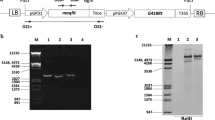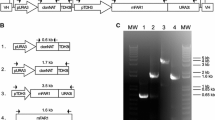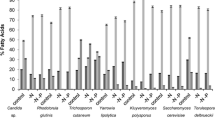Abstract
An oleaginous and psychrotrophic strain (F38-3) of Sporobolomyces roseus Kluyver & van Niel was isolated from a salt marsh environment in Nova Scotia, Canada following a screening program to select for high producers of 18-carbon unsaturated fatty acids. Fatty acid production was characterised as a function of temperature at 20 g glucose L−1, and optimal yields were obtained at 14°C, achieving 5.7 g dw biomass and 39.2% total fatty acids by dry weight, with 18:1, 18:2 and 18:3 all-cis fatty acids accounting for 49.4%, 14.3% and 6.7% of total fatty acids (TFA), respectively—the highest reported for this species. Production of 18:3 was inversely correlated to growth temperature, rising from 2% of TFA at 30°C to 8.9% at 6°C. Cultivation of isolate F38-3 on universally 13C (U-13C) labelled glucose and subsequent transesterification and isolation of the fatty acid methyl esters (FAMEs) by preparative chromatography yielded pure, highly 13C-enriched (>90%) 18:1, 18:2 and 18:3 all-cis FAMEs. The U-13C 18:1 FAME was catalytically converted to U-13C 18:1 trans-9 and purified to >99.5% purity. The U-13C 18:2 was converted by alkaline isomerisation into a 50/50 mixture of 18:2 cis-9, trans-11 and 18:2 trans-10, cis-12 isomers and purified to >95.0% purity. Overall, 10%, by weight, of labelled glucose fed to isolate F38-3 was recovered as fatty acid methyl esters and 7.5% as 18-carbon unsaturated fats, and the final isomerisation reactions resulted in yields of 80% or greater. The ultimate goal of the work is to develop methodologies to produce 13C-labelled metabolic tracers as tools to study the metabolism of trans fats.




Similar content being viewed by others
References
Abranches J, Morales PB, Rosa CA, Mendonça-Hagler LC, Hagler AN (1997) The incidence of killer activity and extracellular proteases in tropical yeast communities. Can J Microbiol 43:328–336
Ackman RG (1997) Has evolution and long-term coexistence adapted us to cope with trans fatty acids? J Food Lipids 4:295–318
Amaretti A, Raimondi S, Sala M, Roncaglia De, Lucia M, Leonardi A, Rossi M (2010) Single cell oils of the cold adapted yeast Rhodotorula glacialis. Microb Cell Fact 9:73
Ascherio A, Hennekens CH, Buring JE, Master C, Stampfer MJ, Willet WC (1994) Trans fatty acids intake and risk of myocardial infarction. Circulation 89:94–101
Belury MA (2002) Dietary conjugated linoleic acid in health: physiological effects and mechanisms of action. Ann Rev Nutr 22:505–531
Bhattacharya A, Banu J, Rahman M, Causey J, Fernandes G (2006) Biological effects of conjugated linoleic acids in health and disease. J Nutr Biochem 17:789–810
Bergauer P, Fonteyne P-A, Nolard N, Schinner F, Margesin R (2005) Biodegradation of phenol and phenol-related compounds by psychrophilic and cold-tolerant alpine yeasts. Chemosphere 59:909–918
Biemann K (1962) Mass spectrometry: organic and chemical applications. McGraw-Hill, New York
Buller AHR (1933) Researches on fungi, vol 5. Longmans, Green & Co., London
Burja AM, Radianingtyas H, Windust A, Barrow CJ (2006) Isolation and characterisation of polyunsaturated fatty acid producing thraustochytrium species: screening of strains and optimization of omega-3 production. Appl Microbiol Biotechnol 72:1161–1169
Davoli P, Mierau V, Weber RWS (2004) Carotenoids and fatty acids in red yeasts Sporobolomyces roseus and Rhodotorula glutinis. Appl Biochem Microbiol 40(4):392–397
Davoli P, Weber RWS (2002) Carotenoid pigments from the red mirror yeast, Sporobolomyces roseus. Mycologist 16(3):102–108
Feldman EB, Kris-Etherton PM, Kritchevsky D, Lichtenstein AH (1996) Position paper of trans fatty acids. Am J Clin Nutr 63:663–670
Freemantle E, Vandal M, Tremblay-Mercier J, Tremblay S, Blachere JC, Begin ME, Brenna JT, Windust A, Cunnane SC (2006) Omega-3 fatty acids, energy substrates, and brain function during aging. Prostaglandins Leukot Essent Fatty Acids 75(3):213–220
Le MP, Fraser C, Gardner G, Liang W-W, Kralovec JA, Cunnane SC, Windust AJ (2007) Biosynthetic production of universally 13C-labelled polyunsaturated fatty acids as reference materials for natural health product research. Anal Bioanal Chem 389:241–249
Matheny PB, Gossmann JA, Zalar P, Arun Kumar TK, Hibbett DS (2006) Resolving the phylogenetic position of the Wallemiomycetes: an enigmatic major lineage of Basidiomycota. Can J Bot 84:1794–1805
McCloy U, Ryan MA, Pencharz PB, Ross RJ, Cunnane SC (2004) A comparison of the metabolism of eighteen-carbon 13C-unsaturated fatty acids in healthy women. J Lipid Res 45:474–485
McCormack PJ, Wildman HG, Jeffries P (1994) Production of antibacterial compounds by phyllopane-inhabiting yeasts and yeastlike fungi. Appl Environ Microbiol 60:927–931
Mensink RP, Katan MB (1993) Trans monounsaturated fatty acids in nutrition and their impact on serum lipoprotein levels in man. Prog Lipid Res 32:111–122
Plourde M, Jew S, Cunnane SC, Jones PJH (2008) Conjugated linoleic acids: why the discrepancy between animal and human studies? Nutr Rev 66(7):415–421
Poitelon J-B, Joyeux M, Welte B, Duguet J-P, Peplies J, Dubow MS (2009) Identification and phylogeny of eukaryotic 18S rDNA phylotypes detected in chlorinated finished drinking water samples from three Parisian surface water treatment plants. Lett Appl Microbiol 49:589–595
Ratledge C (2002) Regulation of lipid accumulation in oleaginous micro-organisms. Biochem Soc Trans 30(6):1047–1050
Razavi SH, Mousavi SM, Yeganeh HM, Marc I (2007) Fatty acid and carotenoid production by Sporobolomyces ruberrimus when using technical glycerol and ammonium sulfate. J Microbiol Biotechnol 17(10):1591–1597
Remig V, Franklin B, Margolis S, Kostas G, Nece T, Street JC (2010) Trans fats in America: a review of their use, consumption, health implications, and regulation. J Am Diet Assoc 110:585–592
Silveira MB, Carraro R, Monereo S, Tébar J (2007) Conjugated linoleic acid (CLA) and obesity. Public Health Nutr 10:1181–1186
van Eijk GW, Roeymans HJ, Weijman ACM (1982) Biochemical characteristics: volatiles, carotenoids, sterols and fatty acids. Stud Mycol 22:39–49
Wolf HJ, Christiansen M, Hanson RS (1980) Ultrastructure of methanotrophic yeasts. J Bacteriol 141:1340–1349
Acknowledgments
The authors would like to thank the Joint Cooperation Program of the National Research Council Canada, National Science Council of Taiwan and the Industrial Technology Research Institute Taiwan for financial support to undertake this work. The authors state they have no conflict of interest and are in agreement to publish in the Journal of Industrial Microbiology and Biotechnology. All experiments described in this manuscript were in accordance with the laws of Canada.
Author information
Authors and Affiliations
Corresponding author
Rights and permissions
About this article
Cite this article
Cui, Y., Fraser, C., Gardner, G. et al. Isolation and optimisation of the oleaginous yeast Sporobolomyces roseus for biosynthesis of 13C isotopically labelled 18-carbon unsaturated fatty acids and trans 18:1 and 18:2 derivatives through synthesis. J Ind Microbiol Biotechnol 39, 153–161 (2012). https://doi.org/10.1007/s10295-011-1010-z
Received:
Accepted:
Published:
Issue Date:
DOI: https://doi.org/10.1007/s10295-011-1010-z




